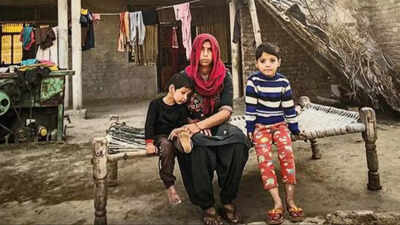Insuring the dying & dead: Multi-crore scam running for 7 years across 8 states uncovered | Lucknow News

A shiny black SUV moved steadily along the narrow road near Rajpura in Sambhal district, its windows tinted. At first glance, there was nothing unusual about the vehicle. But something about the way the driver hesitated as he approached a police checkpoint made officers take a second, closer look. The cops, bored after flagging down speeding cars, had no idea that they were about to uncover one of the biggest, most insidious insurance scams in recent years – one that, quite impossibly, insured the dead and the dying.
“It turned out to be a staggering fraud spanning eight states, involving stolen identities, forged death certificates, and fraudulent medical claims running into hundreds of crores,” a senior police officer involved in the investigations that followed told TOI.”We were looking at a financial crime so meticulously crafted that it had remained undetected for seven years. Neck deep in it were multiple insurance companies, a network of informants feeding details of terminally ill or dead individuals to scamsters.”
How did it unravel? Back at the Sambhal naka on Jan 17, the two men inside the SUV had made an attempt to flee. Cops found lakhs in cash in brown envelopes, and 19 debit cards tied with a rubber band.
Criminals targeted kin of terminally ill individuals
Within hours, the two men — Onkareshwar Mishra, alias Karan, from Varanasi, and Amit Kumar, from Amroha — were taken into custody. The arrests opened the door to a crime that blew sleuths away.
“Mishra worked as an investigator at two Delhi-based firms, East India Company and First Solutions Agency, which conducted insurance claim verifications for multiple insurers. Their job was to verify nominee claims in cases of policyholder deaths. But they were doing the opposite. An FIR was registered, and the duo booked under multiple sections of BNS, including 109 (attempt to murder), 318(4) (cheating for transfer of property), 338 (forgery), 336(3) (forgery to cause harm), 340(2) (using forged documents), and 111(2) (organised crime),” Sambhal SP K K Bishnoi told TOI.
Across UP and beyond, the criminals had been targeting families of terminally ill individuals — cancer patients, those suffering from latestage kidney disease, the bedridden elderly. Agents, often posing as financial consultants, would approach these families and convince them to buy life insurance policies.
When TOIcontacted Shailender Singh, manager at East India Company, one of the investigation agencies at the centre of the scam, he refused to comment. “Police are investigating, we cannot talk,” he said. First Solutions Agency did not respond to calls.
ASP Anukriti Sharma, leading the inquiry, revealed that the fraudsters exploited loopholes in the insurance system by forging documents and manipulating claims. “Scammers approached needy families with terminally ill individuals, telling them about ‘easy’ life insurance policies that would put money in their empty pockets. These gangs would go to the extent of sometimes paying the premiums themselves. After the insured person’s death, they would claim the insurance money, handing over only a tiny fraction of the payout — if at all — to the nominee, who was often unaware of the full claim amount.”
The men who knocked on doors did not evoke suspicion. They were well dressed, polite and patient. They spoke about policies that could help with medical costs and secure the family’s future later. The paperwork was simple.
There was a second, more grotesque, layer to the operation. The fraudsters also insured people who were already dead. Using stolen bank details and colluding with local gram pradhans and secretaries, they forged death certificates, created fraudulent policy documents, & submitted claims.
A case had emerged in Agra during investigation, where a villager who had died in 2020 was issued a death certificate in 2023, allegedly certified by village authorities. The certificate falsely recorded the death as occurring in 2023.
“When we randomly contacted some beneficiaries, most were unaware of any claims in their names. Data also revealed people in several states were involved in the scam,” Sharma added. “Shockingly, in 80% of cases, the money never reached the rightful nominees.”
Under intense interrogation, Neelam Devi, an Asha worker, later admitted to her role. “Two men came to me,” she told police. “They said they were govt officials, collecting health data to help families receive financial aid. They paid me Rs 5,000 per case. I gave them details about terminally ill pa- tients.” She said she never asked what happened next to the details she had provided.
Police officers said the crime network wasn’t made up of just a few individuals running an opportunistic scam. It was a larger ecosystem, operating through insurance investigation agencies like East India Company and First Solutions.
These agencies were meant to verify the nominee claims, ensuring that payouts reached the right hands. Instead, they became key players in twisting the system from within. And the racket spanned several states — Uttar Pradesh, Uttarakhand, Jharkhand, Madhya Pradesh, Bihar, Assam, and Delhi.
By the time police compiled the first tranche of financial records, the numbers were mind-boggling.
So far, 10 insurance companies have been issued notices, with five companies providing data from just two years revealing 1,600 suspicious claims. Almost all deaths in these cases had been attributed to heart attacks occurring within a year — sometimes a few months — of policy issuance.
Among the companies hit were SBI Life, which processed suspected fraudulent claims worth Rs 7 crore in UP; ICICI Prudential Life Rs 4.5 crore, Canara HSBC Life Insurance Rs 7 crore in fraudulent payouts across multiple states. India First Life Insurance disbursed over Rs 10 crore in false claims. “This could be just the surface,” ASP Sharma said. “We suspect the true scale of the fraud to be far greater — potentially running into hundreds of crores. This estimate is based on what we have found so far. The full scale of the fraud is still unknown.”
Experts believe the aggressive push for insurance sales also fuels such scams. Deepak Bhardwaj, chief branch manager at Bajaj Allianz, acknowledged the issue: “Newly-recruited agents face immense pressure to meet sales targets, making them easy prey for cheats.”
Vijay Tripathi, a senior executive at a top insurance firm, explained how thirdparty operators find loopholes to exploit the system. “The traditional agency model, where licensed agents operate under IRDAI (Insurance Regulatory Development Authority) guidelines, is the safest. Nevertheless, IRDAI has mandated the involvement of multiple distribution channels to ensure that insurance benefits reach even the most underserved communities. While this initiative is well-intentioned, it has unintentionally created opportunities for exploitation by third-party entities operating under corporate structures.”
He further added, “Chitfund-style operators have established NGOs to manipulate the system. Direct selling agents (DSAs), insurance investigation agencies, and public service centres in villages and smaller towns — though capable of facilitating reach of policies to rural populations — have also become avenues for fraudulent activities.”
With multiple FIRs already filed, the case is still unfolding. Police are now reviewing thousands of suspicious claims from the last seven years across several states. More names will surface, they say. More arrests will come.
(With inputs from Rahul Singh)







